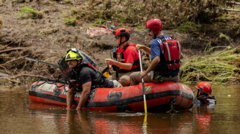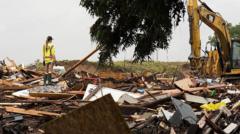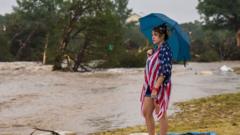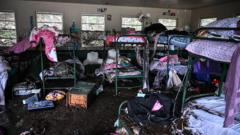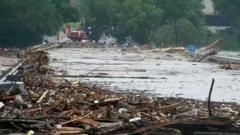As recovery efforts continue, questions are being raised about the efficacy and timing of alert systems as communities grapple with the aftermath of the flooding.
Texas Flood Emergency Alerts Under Scrutiny Amidst Tragedy
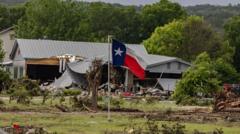
Texas Flood Emergency Alerts Under Scrutiny Amidst Tragedy
Texas officials are facing intense scrutiny regarding emergency notifications during the catastrophic flash floods that have claimed numerous lives.
In the wake of devastating floods in Kerrville, Texas resulting in 96 confirmed deaths and over 160 missing, officials are under fire for their emergency response protocols. At a press conference held Thursday, authorities, including Kerrville Police community services officer Jonathan Lamb, were unable to provide clarity on the timeline of notifications. This came almost a week after the July 4 flooding that inundated the region with approximately 100 billion gallons of rain, causing a rapid rise in the Guadalupe River.
During a distressing exchange with reporters, the specific failures in emergency communication were questioned. Audio recordings revealed that a firefighter had requested an alert be sent out around 4:22 AM on July 4, warning residents to seek higher ground as water levels rose dangerously. However, residents were not notified until nearly six hours later. The first alert via Kerr County’s CodeRED system arrived approximately 90 minutes post the urgent request, in stark contrast to the severity of the unfolding situation.
Kerr County Sheriff Larry Leitha, questioned about the delays, indicated that he was first notified of the escalating crisis around 4 to 5 AM but prioritized ongoing rescue efforts over inquiries into communication failures. Tragically, reports show that there have been no rescues since the floods, sparking further outrage as families await news of their loved ones.
Authorities cited several barriers to effective communication: intermittent cell service, the unexpected intensity of the storm, and a general desensitization to flood alerts in a region prone to such natural disasters. Compounding these issues, a federal disaster declaration signed by President Donald Trump has facilitated support from the Federal Emergency Management Agency, aiding ongoing recovery operations that include efforts from over 2,100 responders, helicopters, and specialized dogs.
Reckoning with the extensive debris left behind, officials emphasize the treacherous and labor-intensive process of recovery as they work to locate both the missing and the deceased amid the mud-soaked landscape. As communities navigate this tragic event, the focus remains on accountability and the imperative for improvements in emergency response systems to prevent similar calamities in the future.
During a distressing exchange with reporters, the specific failures in emergency communication were questioned. Audio recordings revealed that a firefighter had requested an alert be sent out around 4:22 AM on July 4, warning residents to seek higher ground as water levels rose dangerously. However, residents were not notified until nearly six hours later. The first alert via Kerr County’s CodeRED system arrived approximately 90 minutes post the urgent request, in stark contrast to the severity of the unfolding situation.
Kerr County Sheriff Larry Leitha, questioned about the delays, indicated that he was first notified of the escalating crisis around 4 to 5 AM but prioritized ongoing rescue efforts over inquiries into communication failures. Tragically, reports show that there have been no rescues since the floods, sparking further outrage as families await news of their loved ones.
Authorities cited several barriers to effective communication: intermittent cell service, the unexpected intensity of the storm, and a general desensitization to flood alerts in a region prone to such natural disasters. Compounding these issues, a federal disaster declaration signed by President Donald Trump has facilitated support from the Federal Emergency Management Agency, aiding ongoing recovery operations that include efforts from over 2,100 responders, helicopters, and specialized dogs.
Reckoning with the extensive debris left behind, officials emphasize the treacherous and labor-intensive process of recovery as they work to locate both the missing and the deceased amid the mud-soaked landscape. As communities navigate this tragic event, the focus remains on accountability and the imperative for improvements in emergency response systems to prevent similar calamities in the future.





